INDUSTRIAL &
TERMINAL RAILROADS &
RAIL-MARINE OPERATIONS
OF BROOKLYN, QUEENS, STATEN
ISLAND, BRONX &
MANHATTAN:
|
TWENTY FIFTH
STREET / SOUTH BROOKLYN
TERMINAL & RAILROAD
DELAWARE, LACKAWANNA &
WESTERN RAILROAD / |
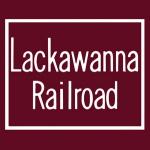  |
D L & W E - L
.....
.
.
|
updated: |
||
|
|
||
| DL&W survey images Steamtown NPS NARA Archives added | 10 October 2025 | |
.
.

| Employees | |||
|
Locomotive Roster |
Marine Equipment |
.
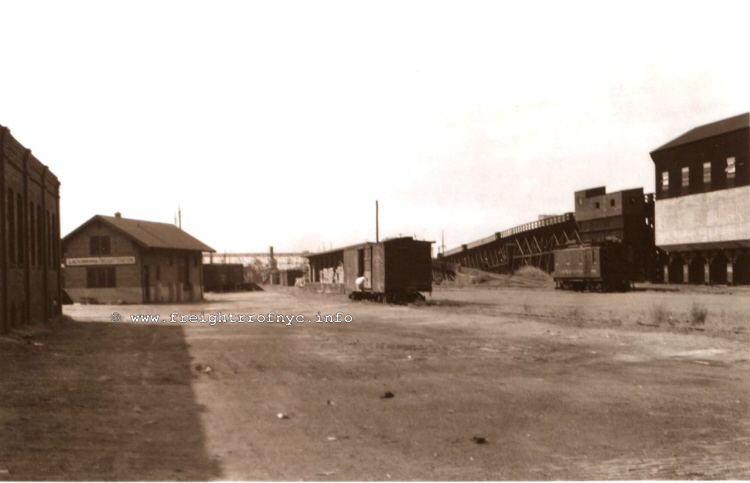
Delaware, Lackawanna & Western RR - 25th Street
Terminal; Brooklyn, NY - 1940
P. L. Sperr photo
NYPL archives
added 08 Dec 2008
.
.
In 1906, the Delaware, Lackawanna & Western (DL&W) Railroad purchased the Brooklyn Dock & Terminal facility which was located between 25th and 26th Streets, and between Third Avenue and the Gowanus Canal in the Sunset Park neighborhood of Brooklyn.
The Delaware, Lackawanna & Western Railroad renamed this facility the "South Brooklyn Terminal" (not to be confused with the South Brooklyn Railway or the proposed South Brooklyn Terminal Railroad), but this facility would be better known as the Delaware, Lackawanna & Western 25th Street Terminal.
This facility would undergo a major reconstruction period sometime between 1929 and 1940, as evidenced by comparing the 1924 Fairchild Aerial Survey Photo and the 1929 E. Belcher Hyde Property Map with the ground level P. L. Sperr photo of 1940 and C. Milster photos of 1960.
Is it believed that the Delaware, Lackawanna & Western Railroad closed their 25th Street Terminal sometime circa 1964.
Aerial photos from historicaerials.com of the property in 1966, shows the area where this facility was located, devoid of freight cars and tracks and most structures razed with the exception of the wood freighthouse, switchback trestle and the Premium Coal Company structure.
The following schematic shows the location of the Delaware, Lackawanna & Western's 25th Street Terminal (in aqua) in relation to the other Offline Terminals and Railways located nearby. Bush Terminal (in red), while only three blocks away, would not connect with the 25th Street Terminal. Please keep in mind this map is not to scale, and is a composite of the various railroads and industries that operated throughout the twentieth century, even though some of the businesses may not have existed all at the same time.
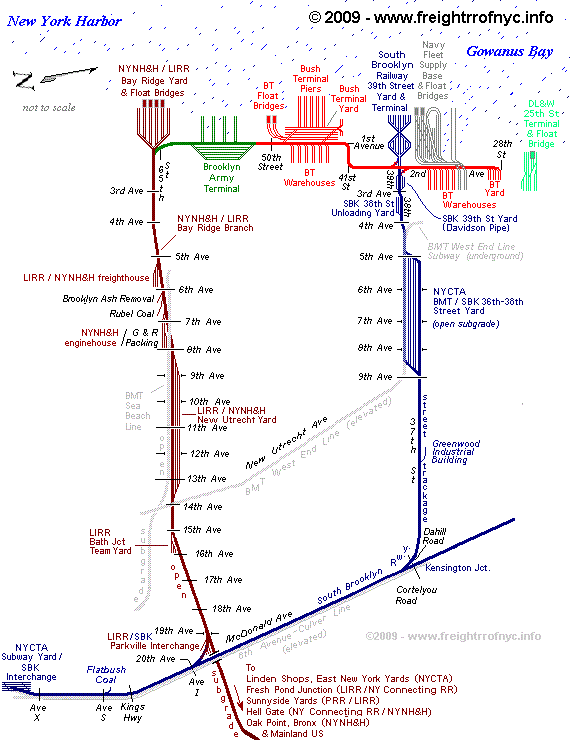
.
.
Prior to Reconstruction - 1906 through circa 1930
A circa 1900 photo postcard released by the Brooklyn Eagle Newspaper (which can be seen on the Brooklyn Dock & Terminal page of this website); shows the ramp of the coal trestle and also includes an elevated view of most of the railyard. It also appears from both the Fairchild Aerial Survey Photo and the postcard that the eastern yard was more developed, and the western yard not quite as elaborate as in later years.
According to the "Report of the Committee on Terminals and Transportation of the New York State Food Investigating Commission" published April 18, 1913; it lists the capacity of the freight house at 9,695 square feet..
In the 1924 Fairchild Aerial Survey Photo below, I have annotated key items: #1 denotes the floatbridge, #2 denotes the "west" yard, #3 is the site of the future coal dock, #4 is the "east" yard, #5 is the freighthouse, #6 is the track ramp leading up to the coal bins, #7 are the coal bins themselves.
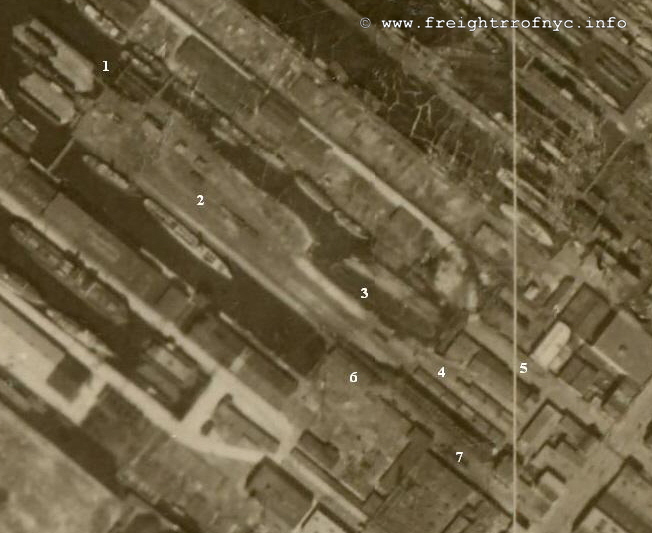
Fairchild Aerial Survey Photo - 1924
NYPL Archives
added 11 Dec 2008
.
.
The 1925 Sanborn Fire Map seen below in the trackage chapter, shows most of the yard trackage as it appeared prior to the expansion and relocation of the coal pockets to the north side of the property.
This map is a moderately large file and may take a few moments to open. Please use the back arrow on your browser to return you here as there is no return link:

Sanborn Fire Map - 1925
added 19 June
2009
.
.
Below is an E. Belcher Hyde Property Map from 1929, that closely confirms to the Sanborn Fire Map above.

E. Belcher Hyde - 1929
NYPL Archives
added 11 Dec 2008
.
..
Shared by Raymond Breyer in the pre-Depression Era Railroad Modelers group on Facebook; are these two images credited to the Steamtown NPS / National Archives collection. They reflect the beginning of reconstruction of the 25th Street Terminal and are dated October 9, 1929.
One of which shows the top of the old coal trestle, the foundation for the "new" coal trestle, the construction of the switch back trestle for the coal silos; and if one looks closely, one can discern DL&W #3001 60 ton boxcab at the end of the string of cars (how anyone could miss those finned roof mounted radiators, is beyond me).

October 9,
1929
Steamtown
NPS / National Archives collection
added 10 October 2025
.
.

October 9,
1929
Note removed trackage, and temporary trackage, and switchback trestle under construction.
Steamtown
NPS / National Archives collection
added 10 October 2025
.
.
One of the most outstanding changes in topography that would take place, is the future site of the Premium Coal Company. From the Fairchild Aerial Survey Photo and the 1929 E. Belcher Hyde Property Map above, there was a much larger and wider basin for ships at 25th Street, than would be in later years.
From viewing this 1924 Fairchild Aerial Survey Photo as well as the 1929 E. Belcher Hyde Property Map and comparing them to either the 1930 Fairchild Aerial Survey Photo or the Army Corp of Engineers Port Terminal Map (after reconstruction), we can see that the Delaware, Lackawanna & Western Railroad 25th Street facility underwent some major changes after 1929.
.
Post Reconstruction
- circa 1930 through circa 1964

Fairchild Aerial Survey Photo - 1930
NYPL archives
added 15 Jan 2008
.
.
In viewing the 1930 Fairchild Aerial Survey Photo directly above, we can now see that the 25th Street basin has been filled in and the new Premium Coal Company switchback trestle already been constructed on the north edge of the property. After the author adjusted the image for contrast, it was discovered that this facility did indeed have a wood Howe Truss float bridge, which can be seen to the left of the trestle, with a carfloat moored to it, which is partially obscured by the wall of the floating dry dock.
Unfortunately, the right edge of the photo above is the edge of the actual Fairchild Aerial Survey Photo and therefore eastern portion of the 25th Street Terminal is cut off from view.
Apparently, either the Premium Coal Company and / or the Delaware, Lackawanna & Western filled in the eastern portion of this basin, thereby expanding the usable land area and subsequently constructed the switchback trestle and multi-story coal silos.
Prior to this construction however, the coal bins and trestle were located on the south edge of the property, adjacent to 26th Street.
The following photo, was located in the New York Public Library Digital Archives. Oddly it was not categorized by railroad, but by street construction (the image was taken during the planning of the Gowanus Expressway) and cross referenced under paper industry (for the structure / occupant that was razed for the construction of the Gowanus Expressway. Needless to say, it is a very unique photograph showing us a rather obscure side of the 25th Street Freighthouse:
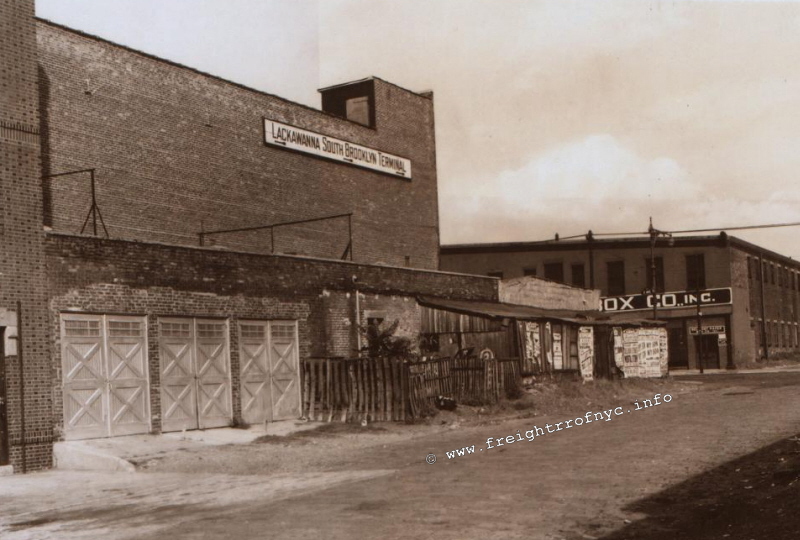
26th Street looking east at Third Avenue - July 21,
1940
Prior to the construction of the Gowanus Expressway (elevated).
P. L. Sperr photo
NYPL Archives
added 22 June 2010
.
.
On 09 February 2010, and after corresponding with Jon Franz regarding various Delaware, Lackawanna & Western Railroad operations in the New York Area, I received a package of documents from him.
Within this package, was a three page letter dated November 11, 1941 and issued by the Delaware Lackawanna & Western Railroad, Office of Superintendent, Hoboken, NJ. At the time of this letter, the Superintendent was Perry Shoemaker.
His letter is quite interesting, and while it pertains to the
official date of cessation of operations at Wallabout, it also specifically
lists:
.
|
|
| .
. |
|
|
|
|
According to the August 1956 issue of "The Lackawanna", freight traffic at the 25th Street Terminal increased with closure of the Delaware, Lackawanna & Western's Wallabout Terminal in 1940, as such time when the Brooklyn Navy Yard expanded and commandeered the Wallabout property.
At the time of the 1956 article in "The Lackawanna" magazine, the 25th Street Terminal was handling five thousand cars per year, with total inbound freight traffic averaging between ten and twenty car per day, and outgoing averaging six cars per day.
The Delaware, Lackawanna & Western's 25th Street Terminal, however limited in size it may have been; serviced many businesses and received a diverse amount of cargo, such as but not limited to: automobiles, cement, poultry and coal.
Several businesses also utilized 25th Street Terminal via their personal rail sidings, with those businesses being American Edible Oil and Celulo-Fibre Companies.
The following image is an excerpt from the Delaware Lackawanna & Western Railroad's 1952 Directory of Industries and Facilities:

.
Many of the following images are from that August 1956 issue of "The Lackawanna" magazine. This magazine was an internal (employees) monthly publication of the Delaware, Lackawanna & Western Railroad. The photographer recorded many scenes of employees in the process of executing their assignments. This is something that usually escapes being recorded for history.
Even more notable, is the fact that the employees names have been included with the photographs. This is also something that is uncommon in many photographic recordings, so we are quite fortunate in this aspect in knowing who we are looking at as they go about performing their duties.
|
Morganstein Building Supply received these bulk cement shipments via this specially equipped team track. Upon arriving at the 25th Street Terminal, the cement would be blown via air pressure into tank style tractor trailers forfinal transport to the cement plant. It is surmised the "specially equipped team track" refers to a blower or compressor building located next to the team track. It is believed that cinder block structure seen at the left edge of the photo at right, is that compressor building. Notice the eyelets on the tops of the cement containers for hoisting. |
|
|
|
There were also several covered platforms at this facility.
One of these covered platforms was dedicated to the inbound
shipments
Four "double door" boxcars can be located on either side The other covered platform at the 25th Street Terminal had a six railcar capacity (three on each side of the platform) and was used for the loading and unloading of mixed freight. Team tracks at the 25th Street Terminal would receive a great deal of varied and diverse commodities, such as: machinery, lumber, paper, felt, starch, flour, powdered milk, television sets and washing machines. |
| Both inbound and outgoing "less than carload" freight using
the 25th Street Terminal was handled by the Acme Fast Freight Company, which
offered expedited freight service. Seen in the photo to the right are employees in the process of loading less than carload freight for shipment to New Jersey and subsequent re-distribution. Acme Fast Freight dispatched approximately two to three railroad cars of "less than car load" freight daily.
|
|
| ..
. |
|
|
|
|
| . . |
|
|
|
|
| .
|
|
|
The following two images (among several others seen on this page) were captured on film by Conrad Milster in 1960:.
|
|
| .
. |
|
|
|
|
.
.
Premium Coal Company
The most significant commodity arriving at the 25th Street Terminal was anthracite (hard) coal for the Premium Coal Company. The Premium Coal Company silos were among the largest in Brooklyn.
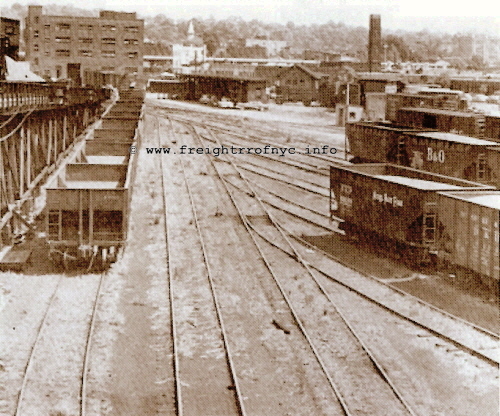
ca. 1956 - looking east (Premium Coal Company trestle on left)
photo from "The Lackawanna", August 1956
issue
added 15 Jan 2009
.
This coal facility had a unique
"switchback" trestle for the locomotive to ascend with hopper cars, which
was built in 1929 and this coal dock had a most unusual
affair for unloading railroad cars full of coal via that switchback, and
is worth mentioning.
.
The locomotive would pull a string of coal hoppers (heading east) off a carfloat onto a stub track.
The locomotive would then uncouple, run around the hopper cars, and couple up to the west end, where it would push the cars east and past a switch.
This switch would be thrown at the rear of the locomotive and then the locomotive would reverse direction (heading west again) and ascend a wood trestle pulling the hopper car(s) up the trestle, entering yet another stub track and stop.
Another switch (which the locomotive and hopper car(s) passed over, was thrown behind the last hopper car, and the locomotive would then reverse direction (now heading east again), now pushing the hopper car(s) further up the trestle and thereby climbing even higher.
The locomotive and hopper car(s) would then enter the facility near the top of the building and at this time, the hoppers would dump their contents directly into the coal silos below the track.
By this arrangement above, the locomotive would be pushing the hopper(s) up the final ascent and on the west side of the hopper(s). By pushing them up from the west side of the train, prevented the locomotive from being "trapped" behind the hopper(s) in the coal structure (as it would be if the locomotive pulled the hopper(s) from the east end of the train). This arrangement would also allow the hopper(s) to be uncoupled from the locomotive and left in the coal structure if need warranted it, while the locomotive would be free to perform other switching duties.
Conrad Milster was more than fortunate enough to photograph the trestle from several vantage points, including from the locomotive transversing the trestle on April 15, 1960.
|
|
| .
. |
|
|
|
.
. |
|
|
| .
. |
|
|
| .
. |
|
|
The track leading to the "switchback" coal trestle is the northernmost track on the property show in the Port Terminal Map above. Seen between the box car and the left edge of image in the photo directly below, one can make out the lower section of the trestle ramp in front of the higher section, as well as the wood cribbing and ramp for initial start of the incline, just above the head of the trainman on the right.
The Premium Coal Company silos can be seen in the following photo, taken by C. Milster and dated April 1960:
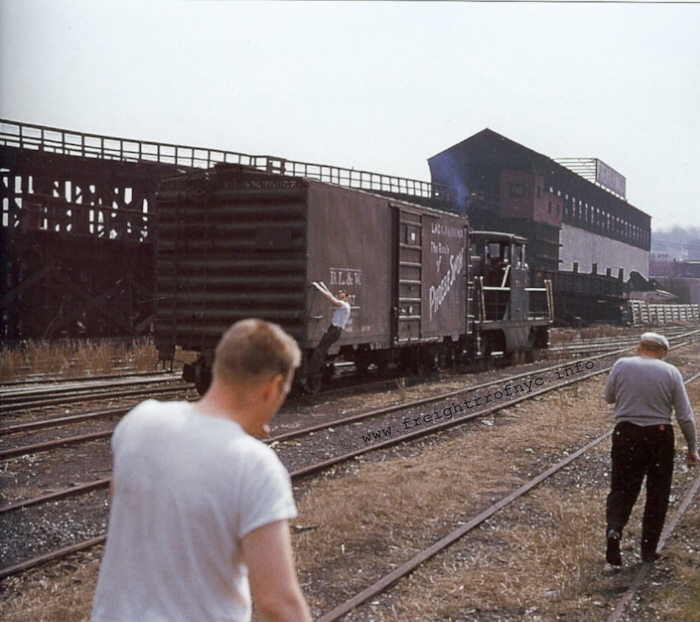
Delaware, Lackawanna & Western 25th Street
Terminal - April 15, 1960
C. Milster photo
authors collection
Unfortunately, the true reasons as to why the Delaware, Lackawanna & Western's 25th Street Terminal closed circa 1964, has not yet been ascertained or discovered.
We can only assume that the reasons for this terminal's closure, were the same as for the other Class 1 terminal located in Brooklyn (the Pennsylvania Railroad's North 4th Street Freight Station), which closed this same year and in which was due to the decline in rail-marine traffic.
This was most likely due to the increase in long distance tractor trailer hauling, which was due in part to interstate highway system. With the opening of the Verrazano Narrows Bridge in 1964 linking Staten Island (and with it New Jersey) with Brooklyn, it was now possibly to transport freight directly from New Jersey piers and railyards directly into the heart of Brooklyn. This highway connection thereby eliminated a costly, labor intensive and time consuming step in having to handle that freight by carfloating it across New York Harbor.
Also considering that Bush Terminal was merely a few blocks south, would come to mean that the 25th Street Terminal became duplicitous in its existence as a general freight handling facility.
While the independent contract terminals: Bush Terminal, New York Dock and the Brooklyn Eastern District Terminal did not close by this point in time, they too were beginning to suffer the decline in carfloat freight traffic.
The following aerial image, is attributed to the Port of New York Authority and was taken on January 15, 1964 at an altitude of 800 feet. It was graciously provided by Al Galanty. It shows the 25th Street Terminal in its last days.
Pay particular attention to the four strings of loaded hoppers. Even at this late date, it is apparent coal was still a primary source of revenue for this facility, even though coal was rapidly losing favor as a heating source and therefore inbound coal traffic must have been diminishing.
Please click on the image below to take you to an even larger image. Use the back arrow on your web browser to return you here:
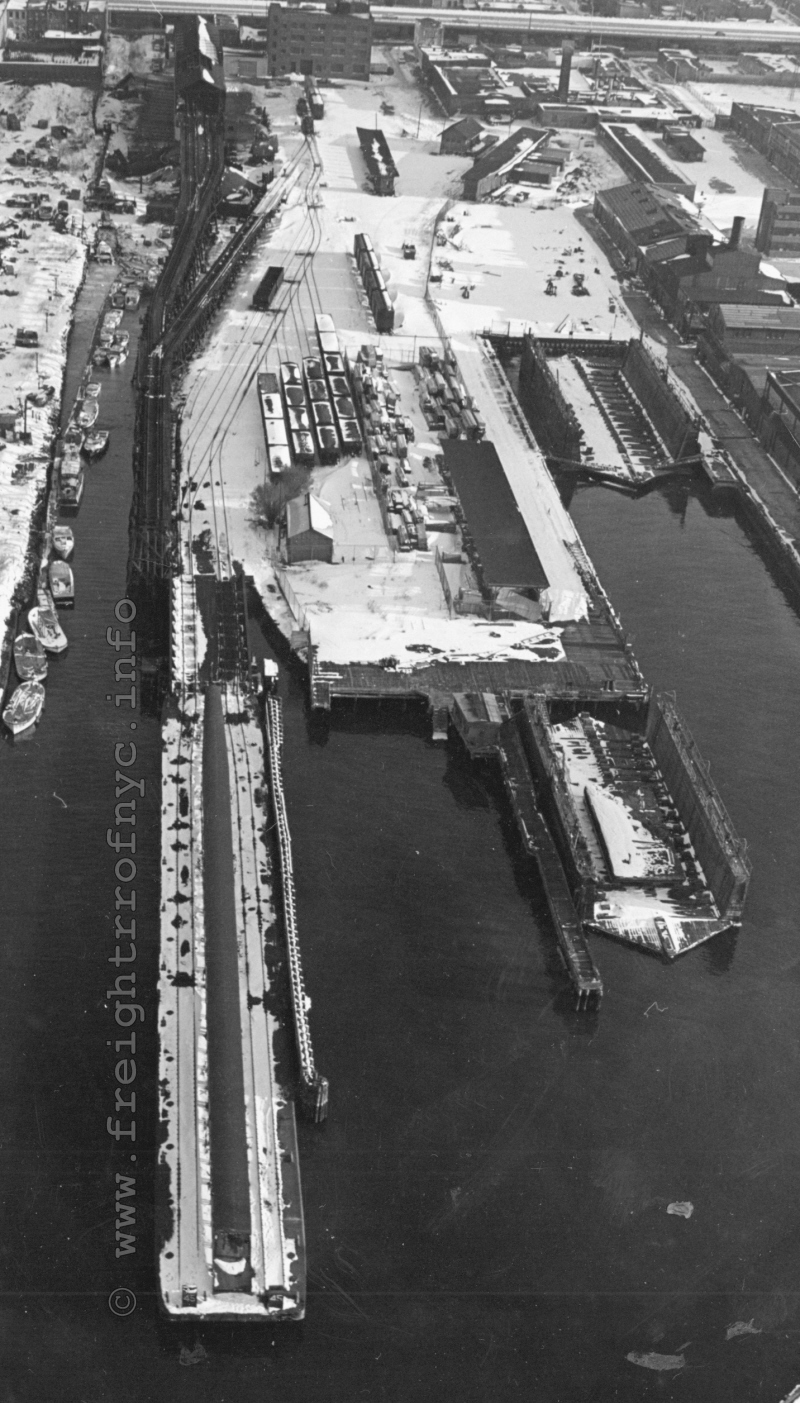
Delaware Lackawanna & Western 25th Street Terminal - January 15, 1964
Looking east.
Port of New York Authority photo
A. Galanty archives
added 26 March 2010
.
.
The reasons stated above and probably a few other factors were stacked against this facility's survival, which left the Delaware Lackawanna & Western Railroad no choice but to close this facility.
Following the closure of this facility, the westernmost portion of the property and bulkhead would come to be owned by Moore McCormick shipping lines. It is now occupied by a cement plant.
The eastern portion of the property however would be subdivided into lots. Here, a bit or irony and personal coincidence arises.
The family of one of my closest childhood friends, Dave Gellerstein; operated a scrap metal firm in South Brooklyn and of which closed a few years ago. I didn't think much of it until recently, when we reconnected after drifting apart . We subsequently went exploring the South Brooklyn area for remnants of the South Brooklyn Railway, and Bush Terminal.. Dave asked if we go down to the former property of his family's business to which I said, "sure why not?"
When we made the turn west off Third Avenue onto 25th Street, it dawned on me. This was the former location of the Delaware, Lackawanna & Western's 25th Street Terminal! When I said this to him this used to be a D. L. & W. offline terminal, he matter-of-factly replied, "Yeah, when grandpa Bernard moved "Basic" (Basic Scrap Metal) out of 263 South Street, he bought the 25th Street property from Moore McCormick Lines (shipping). The railyard was across the street (south). We always knew that place was on an old railyard. I just didn't know which."
As adolescents, we are only interested in the Brooklyn Eastern District Terminal so he never thought to mention this to me!
.
One of the benefits of "internal" publications, such at the "The Lackawanna" Railroad Magazine, is the amount of information on the employees mentioned.
Upon reading the article in the August 1956 issue of "The Lackawanna", the Delaware, Lackawanna & Western 25th Street Terminal had employee roster of 13 people.
Unfortunately, this magazine does not list the tenure or years of service of these employees, as did the Erie Railroad Magazine did for those employees at Harlem Station. So for now, until more data surfaces, their years of service are marked for both prior to and after 1956 (denoted by < 1956 >).
|
Employee Roster - Delaware, Lackawanna & Western RR 25th Street Terminal, 1956
|
.
.
According to the "Report of the Committee on Terminals and
Transportation of the New York State Food Investigating Commission" published
April 18, 1913; it lists the Delaware, Lackawanna & Western 25th Street
Terminal having 1.909 miles of trackage at this location on that date.
The purpose of large structure at east end of the main yard (Third Avenue between 25th and 26th Streets and seen in the Port Terminal Map below) remains unknown. It is undetermined if this building was a new and larger freighthouse, or whether a portion of it might have served as an enginehouse, as at least one track enters the structure according to the Port Terminal Map below.
The 1925 Sanborn Fire Map seen below, is a pretty accurate representation of, and shows most of the yard trackage as it appeared prior to the expansion and relocation of the coal pockets to the north side of the property.
This map is a moderately large file and may take a few moments to open. Please use the back arrow on your browser to return you here as there is no return link:

Sanborn Fire Map - 1925
added 19 June
2009
.
.
As mentioned above, the Delaware, Lackawanna & Western Railroads 25th Street Terminal would be reconstructed around 1930, with yard trackage on the west end of the property being greatly expanded.
. There was a small wooden freight house (seen in the P. L. Sperr photo at top of page) that was located at foot of the diagonal four track yard.
By viewing the 1930 Fairchild Aerial Survey Photo above, it is clear there was a wood Howe Truss float bridge originally at this facility. Between 1930 and 1960, the Howe Truss float bridge was replaced by a pony plate girder float bridge.
In 1956, according to the Erie publication "The Lackawanna", the 25th Street Terminal had a capacity of 150 cars.

Delaware, Lackawanna & Western 25th Street
Terminal - after reconstruction
Army Corp of Engineers Port Terminal Map
(modified)
Please note the original Port Terminal Map was congested with many symbols denoting the many drydock services in the area, so I took the time to modify the map for clarity and better orientation for north, but I did not change track layout, track length or structures.
The oblate hexagonal shapes marked FDD at the left end of the yard (under the number 98) are not actually Delaware, Lackawanna & Western property, and are floating drydocks belonging to the Bethlehem Steel Shipyard and United Dry Dock.
The 1940 photo at the top of the page, located and submitted by Joe Roborecky; is of the east (Third Avenue) end of the terminal. Behind and to the right of the boxcar; appears to be a covered transfer platform. To the left of the boxcar is a peaked structure marked Lackawanna Freight Station. Behind that building is another boxcar with what appears to be a platform and ramp.
Tom Flagg dropped this big beauty on me, during a recent research get together at his office with Joe Roborecky on 10 June 2009. It is a Right of Way & Track Map issued by the Delaware, Lackawanna & Western Railroad for their South Brooklyn Terminal and drawn by their Office of the Chief Engineer located in Hoboken, NJ.
The map does not appear to have a date, but the last entry for deed transfer is shown as 1958. With the terminal closing circa 1964, this map is in all probability, the last track diagram issued for this facility. Therefore this is probably the way trackage appeared upon cessation of service at the 25th Street / South Brooklyn Terminal.
I was taken aback by the fact that the 25th Street / South Brooklyn Terminal was part of the Morris and Essex Division of the Delaware Lackawanna & Western Railroad. So, if any DL&W fans out there can check Morris & Erie Division Employee Timetable / Special Instructions for information on this facility, and forward same to me, I would be most appreciative.
Click on the thumbnail image below to view a high resolution large scale version of the track map. It is a rather large file, so please be patient while it opens. Please use the back arrow on your web browser to return you to this page, as there is no link to return you here.
.
.
Of a slightly unusual arrangement and another unique feature of this facility, is the long "gantlet" track paralleling the left float bridge track. In this case, this gantlet track accessed the middle track of three track interchange carfloats. On the majority of float bridges at other locations, a low profile switch throw was mounted near the end of the float bridge between the rails, shortening the distance for access to the middle track.
In relocating the switch to land however, some ninety plus feet away from the actual center track; required a "gantlet track" arrangement on the float bridge:
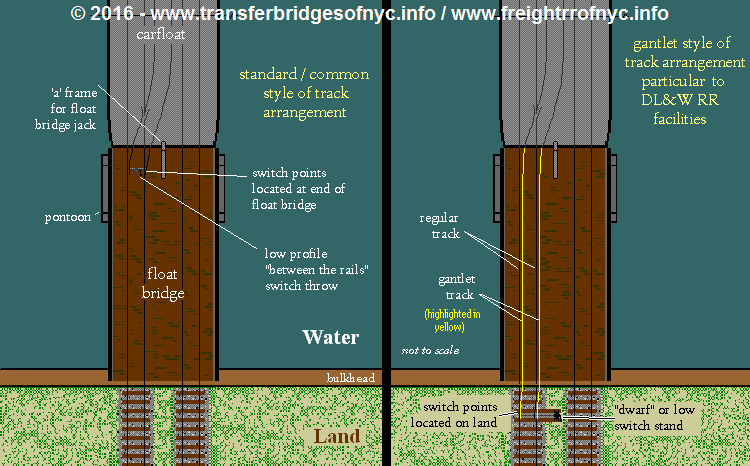
.
.
It appears that the Delaware, Lackawanna & Western RR preferred this gantlet track set up on their float bridges, as they also used this same arrangement at their Harlem Transfer Company facility in the Bronx, as well as the many float bridges at their main facility in Hoboken, NJ.
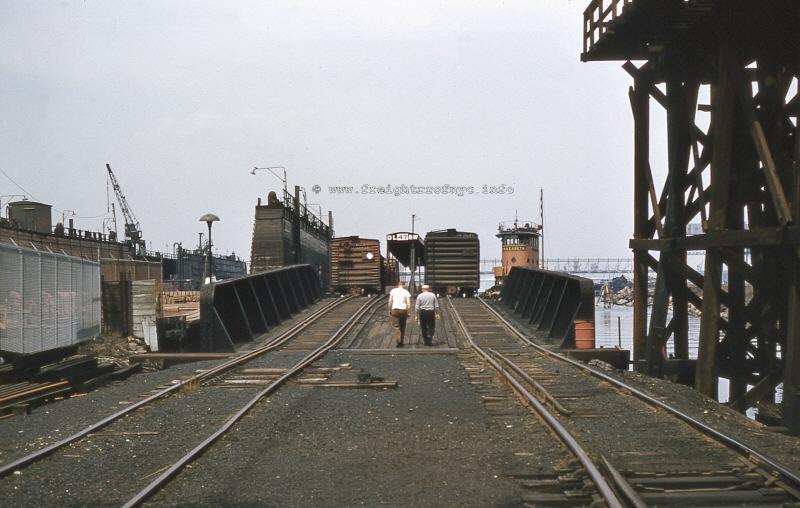
Delaware, Lackawanna & Western 25th Street
Terminal Float Bridge - April 15, 1960
D. L. & W. tugboat "Nazareth" & D. L. & W. Carfloat #47
C. Milster photo
authors collection
added 27 May
2009
.
.
The photo above better shows the float bridge portion of this terminal, what with the switchback coal trestle looming over the float bridge and the wooden wall to the left outer end of the float bridge, which is one of the floating dry docks belonging to the neighboring ship yard.
Also, this photo shows gantlet track arrangement (double set of tracks on left side of float bridge) that the Delaware, Lackawanna & Western RR preferred to use to access the center track of three track interchange carfloats.
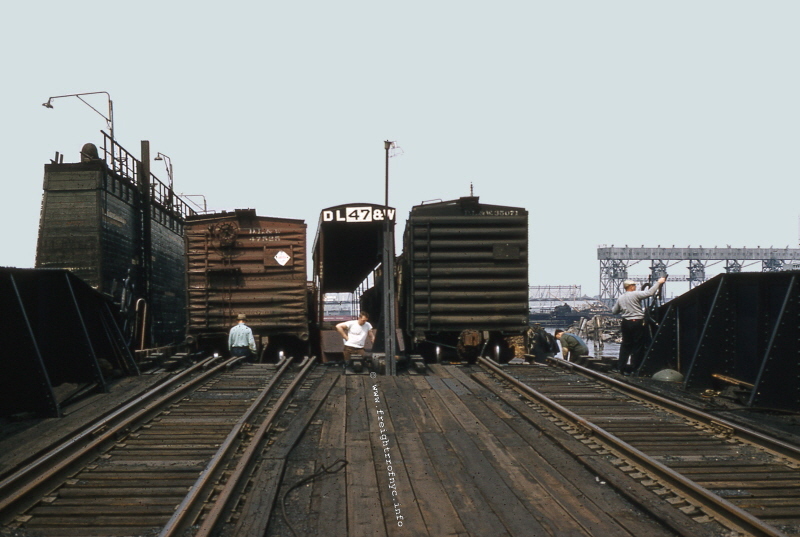
Delaware, Lackawanna & Western 25th Street
Terminal Float Bridge & Carfloat #47 - April 15, 1960
C. Milster photo
authors collection
added 27 May 2009
.
The Delaware, Lackawanna & Western operated at least three locomotives at this facility, with the distinct possibility of more.
.
#8
The first known locomotive, was an 0-6-0T side tanker with sloped side tanks. This locomotive was acquired when the Delaware, Lackawanna & Western Railroad purchased the property from Brooklyn Dock & Terminal. This locomotive would be renumbered #8. It is believed that in 1914, the locomotive would be renumbered again to #173, as it was stated on the Erie Lackawanna Historical Society's "Condensed Steam Roster", but apparently this has been amended as this notation is not listed anymore.
So far, I have been unable to find this 0-6-0T locomotive in
Delaware, Lackawanna & Western Railroad
livery, but a photograph of this locomotive does exist as built and marked
for the Brooklyn Dock and Terminal. This photo may be seen on the the Brooklyn
Dock & Terminal page of this website (link below). The Erie Lackawanna
Historical Society shows this locomotive to have been retired in 1926.
You can read the comprehensive history of all steam locomotive
restrictions for the City of New York, beginning 1834 and ending with the Kaufman Act and its repeal on the main page
of this website: Steam Locomotive Regulations within the City of New York. It is very much worth a read, because there are misconceptions about the Kaufman Act, i.e. such as it was repealed in 1930.
.
#3001

#3001 Clearance Card
authors
collection
added 17 July 2010
.
The history of this locomotive shows that the Delaware, Lackawanna & Western Railroad purchased two identical American Locomotive / General Electric / Ingersoll Rand boxcab locomotives in June 1926; in response to the Kaufman Act legislation banning steam locomotives within the City of New York. Coincidentally, this is the same year that saddletank locomotive #8 was retired.
One of these American Locomotive / General Electric / Ingersoll Rand boxcabs (c/n 66684 / 10027) would be lettered Harlem Transfer #2, and assigned to that Delaware, Lackawanna & Western subsidiary facility in the Bronx. The other boxcab would be marked Lackawanna #3001 (c/n 66683 / 10026) and used here at 25th Street.
According to the 1940 photo at the top of the page, we can now see a boxcab locomotive at this yard. While we cannot make out the number with 100% certainty, it is believed this loco was #3001.
These would be the only two General Electric / Ingersoll Rand boxcabs purchased by the Delaware, Lackawanna & Western Railroad, yet there had been no definitive proof of #3001 being used at the 25th Street Terminal, although we did know from other information that this locomotive was in fact assigned to carfloating duties in the New York Area.
However, on 15 January 2009, the author located an image of this locomotive marked as 1926 - Brooklyn, NY; and this now confirms this locomotive to have been used at the 25th Street Terminal.
In July of 1951, #3001 was sold back to Ingersoll-Rand, where it would continue to serve as their plant switcher #91. In 1977 it was the oldest operating diesel-electric powered by its original Ingersoll Rand engine and related electrical equipment. Over fifty years of active service! In early 1984 Ingersoll-Rand donated this historically significant locomotive to the Illinois Railway Museum at Union, Illinois.
.
#401
Being brought to my attention, is the existence of a photo in the book "Alcos HH Series" (2006, Withers Publishing) of Delaware, Lackawanna & Western locomotive #401 in front of the coal trestle at 25th Street.
This locomotive was originally built as American Locomotive Company as their Demonstrator #603 in February of 1933. This locomotive would be purchased by the Delaware, Lackawanna & Western Railroad and as evidenced by this photo, subsequently used at 25th Street. This locomotive was a model HH600, which denotes High Hood, 600 horsepower. The HH600 model would become the predecessor to the ALCo model S1.
Exactly how long this locomotive operated at the 25th Street Terminal is uncertain.
.
#51 & #53
In 1948, the Delaware, Lackawanna & Western Railroad ordered and purchased three General Electric 44 Ton diesel locomotives, These were numbered 51, 52 and 53.
We know #53 was assigned to this facility, by evidence of the photographs below.
It is understood #53 was in service at this location until this facility closed circa 1964. At that time is was transferred to and re-lettered (but not renumbered) for the Harlem Transfer Company, which was a Delaware, Lackawanna & Western Railroad subsidiary.
As other photos have made their way into the light and have been contributed, we have learned that locomotive #51 operated at the 25th Street Terminal as well.
Whether #51 and #53 were swapped out for inspection dates is not known at this time. Also as of this time, we have no photographic evidence that #52 operated at this location either.
#51 has a somewhat interesting history. While it had been purchased new by Delaware, Lackawanna & Western Railroad, it was leased to the Lackawanna & Wyoming Valley Railroad for a period of time. As it turned out, #51 did not have sufficient strength to switch freight cars for that railroad, so it was sent back to the Delaware, Lackawanna & Western in late 1953.
.
.
|
|
| .
. |
|
|
| .
. |
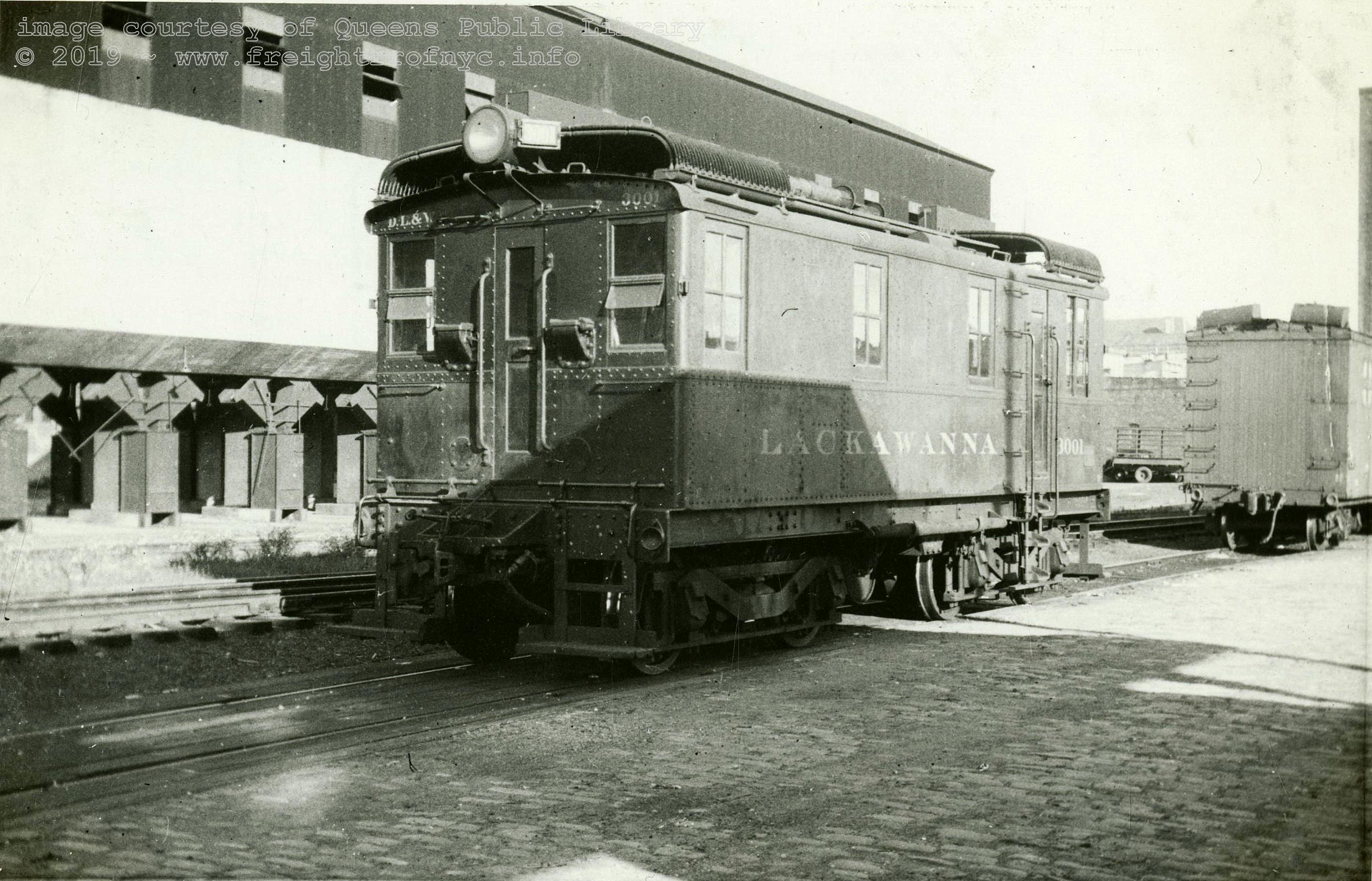
#3001 - 1938 - Brooklyn, NY
Note Burns Bros. sign no longer on coal dock. William J. Rugen photographer image courtesy of Queens Public Library Digital Archives color corrected by author added 21 May 2019
|
| .
. |
|
|
| .
. |
|
|
| .
. |
|
|
| .
. |
|
|
.
.
.
.
Twenty Fifth Street Terminal
(DL&W) Roster
| number / name | builder | c/n | model | build date |
gauge |
wheel arrangement |
wheel dia |
cylinders |
acquired |
disposition |
notes | ref |
| #8 | Baldwin | 23868 | 3/1904 | std. | 0-6-0T | 46 1/2" | 19" x 24" | ex-Brooklyn Dock & Terminal #2 | renumbered DL&W #8 in 1906; scrapped 9/1926 |
[2] [33] [37] |
||
| #3001 | ALCo / GE / IR | 66683 / 10026 | boxcab | 6/1926 | std. | B-B | new | to Ingersoll Rand #91, Phillipsburg, NJ; currently under restoration at Illinois RR Museum |
[a] | [36] [44] |
||
| #401 | ALCo | 68609 | HH600 | 2/24/1933 | std. | B-B | demo / used | retired 1959, scrapped |
600 hp High Hood formerly ALCo demonstrator #603 seen in photo in Alco HH series book Possibly used as relief loco. |
|||
| #51 | GE | 29986 | 44 Ton | 10/1948 | std. | B-B | new | [c] | #51 acquired new by DL&W, leased to Lackawanna & Wyoming Valley before arriving back at DL&W. | [e] | ||
| #53 | GE | 29988 | 44 Ton | 11/1948 | std. | B-B | new | to Harlem Transfer #53, 1964? [d] | [b] | [23] [55] |
Locomotive Footnotes
| [a] | length: width: height: weight: gear ratio: hp: |
34' 10" 10' 14' 4" 132,000 lbs. 82:14 300 |
| [b] | weight: gear ratio: |
89,000 lbs. 11.25:1 |
| [c] | DL&W #51 (and #52) sold 7/1965
to Samuel M. Pinsley for his short lines Hoosac Tunnel & Wilmington (#32)
and Claremont & Concord (#31), respectively. HT&W ceased operations August 2,1981 and #32 sold to nearby Rock of Ages quarry, where it remains at last report, in Graniteville, VT. C&C #31 still active. . |
|
| [d] | Harlem Transfer abandoned about
7/1968 and #53 sold October 11, 1968 to Weston & Brooker Quarry (Sand
and Gravel) #53, Camak, GA (joining ex-NKP GE 44-ton 90). W&B bought out by Martin-Marietta, Camak, GA; and unit renumbered 18562, later renumbered 14 (by 10/1974). Transferred to Martin-Marietta, Warrenton, GA. Apparently all three are still operating. |
|
| [e] | Acquistion information comes via "Trackside around Scranton 1952-1976" by Chuck Yungkurth; Morning Sun Publications. | |
.
Being a Delaware, Lackawanna & Western operation, the South Brooklyn / 25th Street Terminal would have been serviced by Delaware, Lackawanna & Western Railroad tugboats, carfloats and lighters.
Keeping in mind the significant amount of marine equipment that the Delaware, Lackawanna & Western Railroad owned and operated, and not knowing if there was equipment specifically assigned to this facility (it is highly unlikely they did), a Marine Roster on this website would not be beneficial or justified; and therefore will not be forthcoming.
However:
It should be noted due to the restricted space in the 25th Street Basin where the float bridge was located, it is known that the Delaware, Lackawanna & Western used a shorter carfloat than that of one regularly used at other offline terminals.
The following excerpt is from an internal memorandum regarding the closure of the Wallabout Terminal. The memo was issued by the Office of Superintendent, Delaware Lackawanna & Western RR, Hoboken, NJ. At the time of this letter, which is dated November 11, 1941; the Superintendent was Perry Shoemaker:

Most if not all railroads had "shortie" carfloats, that could be used at this 25th Street Terminal, so there is in all probability others.
Specific usage of the shortie carfloats at this location was not set in stone however, as photos above show Carfloats 45 and 47 at the 25th Street Float Bridge.
.
.
DL&W 25th Street Terminal Carfloat Roster
|
|
||||||||||||||||||||||||||||||||||||||||||||||||||||||||||||||||||||||||||||||||||||||||||||||||||||||||||||||||||||||||||||||
.
Like what you see? Suggestions?
Comments?